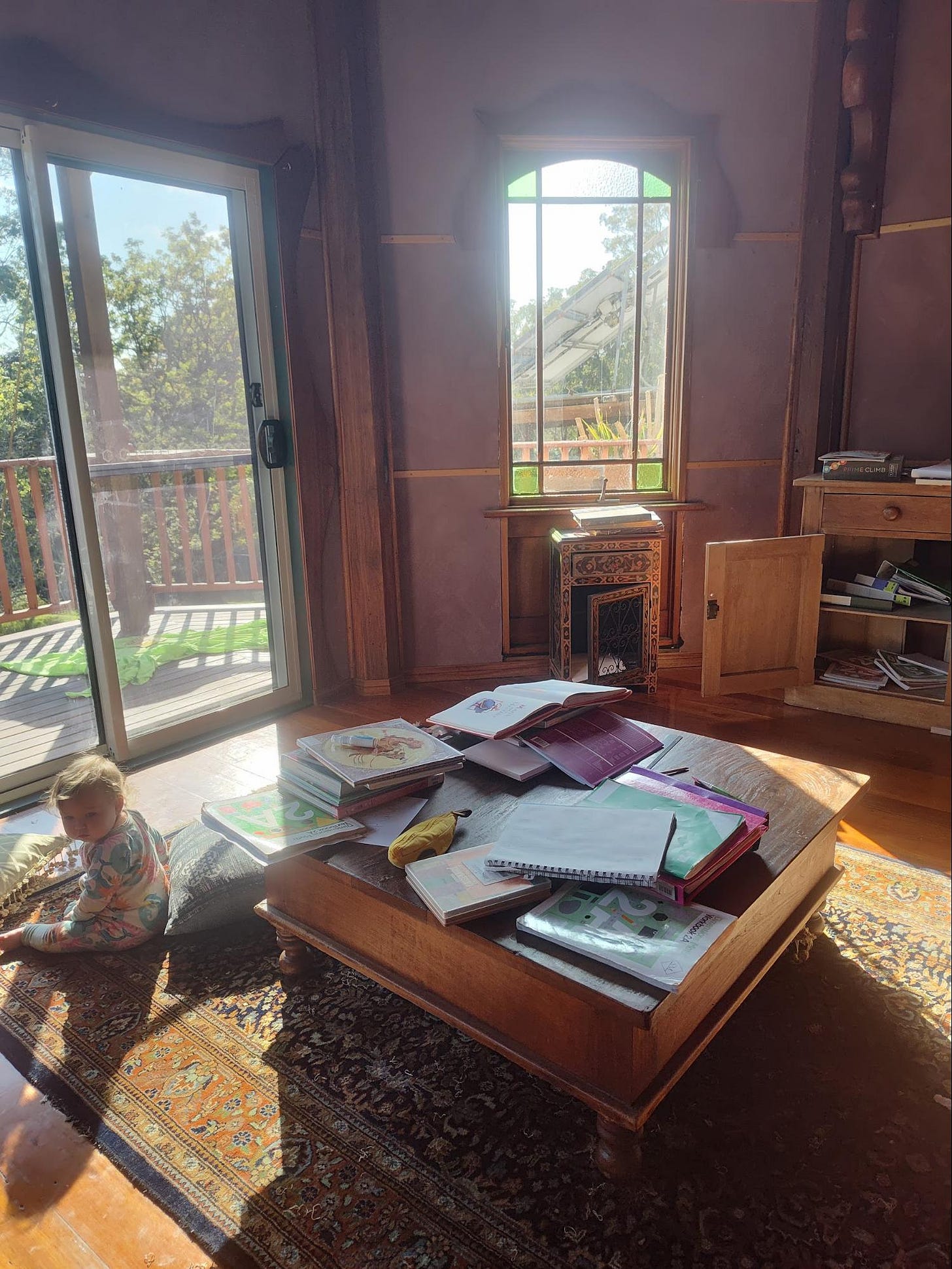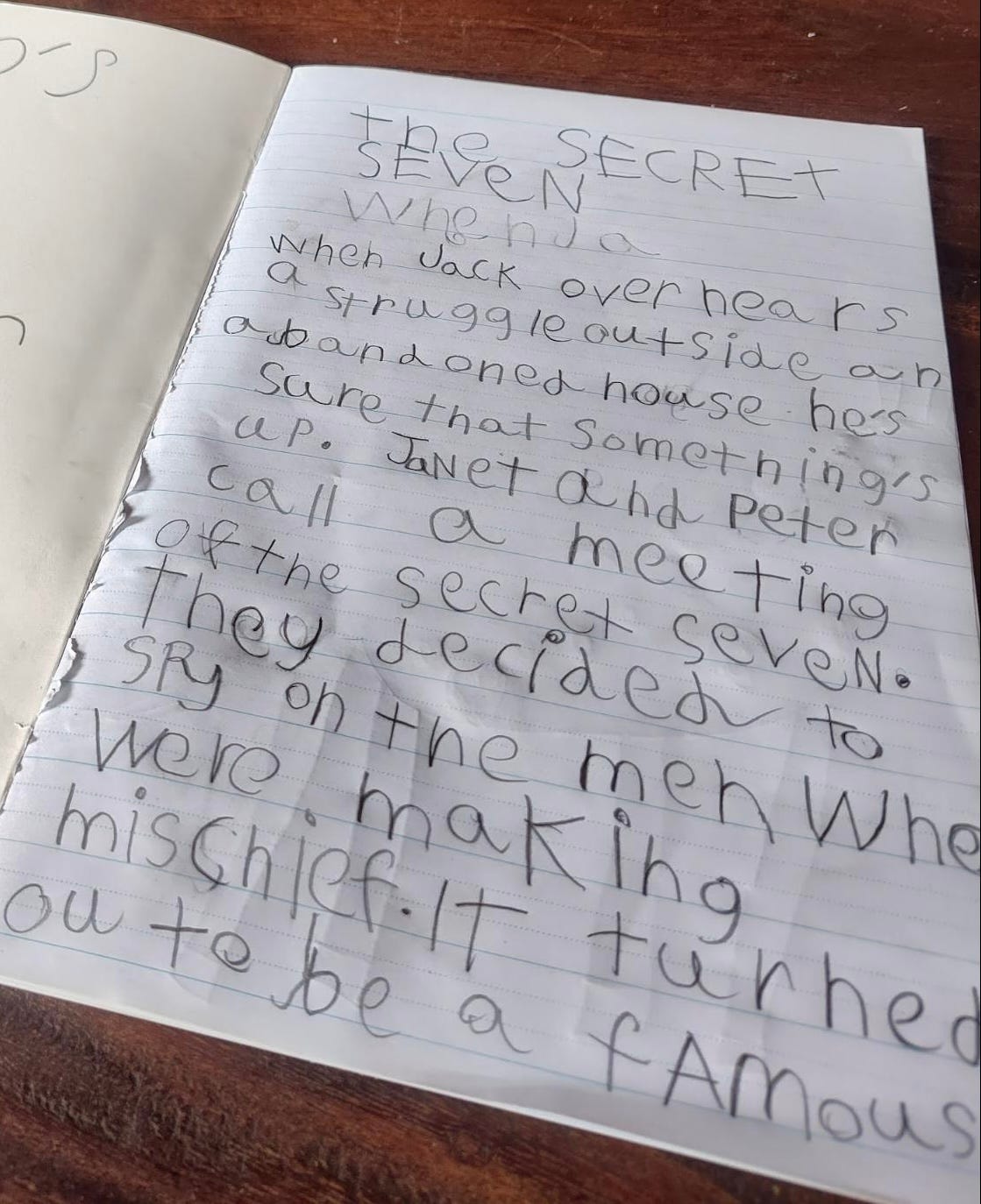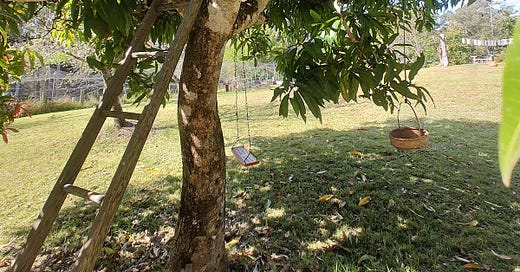Special guest edition: How we homeschooled today by Nicola Trethowan
Oh, for a mango tree to read in.
Nicola kindly got in touch with this ‘day in the life’ of her well-travelled young family. If you’d like to read previous guest posts, have a look at the Special Guest Editions tab on the How We Homeschool homepage.
[Substack is being a bit funny about image captions, so some of them look a bit different to others in this post!]
It is a truth universally acknowledged that when life changes, homeschool changes. Our family has been riding on a wave of change for the last 12 months: in addition to the birth of our baby daughter, L., we have lived in four different locations since leaving our previous home in the remote rainforest of Espiritu Santo, Vanuatu. Our eldest daughter, R., who is now nearly 7, was born there and I have educated her at home since she was preschool age.
In the past, my approach to homeschool was very hands-on and faithful to the Classical structure set forth in The Well-Trained Mind, with the inclusion of a lot of guided nature play in the forest, relaxing by the riverside and luxuriating in the shared joy of reading aloud on quiet afternoons. However, now that we have at last settled in a permanent place of our own (a homestead in rural Australia) and I have baby L. to manage as well as more household and garden projects, I am needing R. to work independently on certain aspects of schoolwork until I have time to oversee things.
So this post is about the dance we are doing between supervision and independence, academic structure and unschooling, meeting the educational needs of my young learner and caring for a delightful new baby. It is the document of a day that I wish I could have read whilst pregnant with L., and I hope that it may be instructive to others who may be doing this dance in the future.

We are out of bed at 6 and start the day, as we do every day, having a cup of tea out on the porch as R. eats her porridge. Today my husband and I are speaking on practical matters, but oftentimes this moment on the cusp of the day’s beginning is given over to ad hoc discussions on spiritual or philosophical topics. My husband has indirectly schooled R. on the basic texts and teachings of Christianity, Buddhism and Hinduism in this way through dialogues over tea and mealtimes; comparative religion is not a formal part of our education but certainly establishes the context of our way of life as a family living off-grid and close to nature. Meditation and devotional practices such as singing and chanting are part of what we do as a family, interstitial to R.’s academic subjects and our work together on the land.
When my husband gets started on his daily projects at 7.30, I adjourn to the classroom with the girls for R.’s maths lesson. We are working through Singapore Math Dimensions 2A and have reached the first lesson on multiplication, which R. finds easy as we have already done a lot of game based, informal practice on this topic. We started Singapore Math Dimensions at Level 2, and it is working well for us so far: I appreciate the clear, methodical approach to maths concepts, which gives me confidence that we are on track with R.’s maths. We always keep our Cuisenaire Rods and a sheet of scratch paper on hand to explore different ways of tackling a maths problem.
I managed to find the curriculum materials for Singapore Math Dimensions second-hand for a good price on eBay, as the cost would have been otherwise extortionate for a full year of tuition materials (2 workbooks, 2 textbooks, 2 home instructors guides plus 2 books of tests! Just for second grade!!) Whilst I am working on maths with R., baby L. wriggles on the floor with a toy, gradually getting cranky and ready for her morning nap.
At 8.00 I set R. a page of sums in her workbook to work on independently, then put on a load of laundry before heading upstairs to take a (now quite fussy) baby to bed. After settling her for about 15 minutes I manage to sneak away to go and check on R., but the baby stirs as I am going downstairs so I go back and nurse her back to sleep (whilst reading Substack essays to pass the time).
At 8.20 the baby is fast asleep so I go back downstairs to check over R.’s answers; then we start a game of Prime Climb (US link here) to round off our maths work for the day. I bought Prime Climb (another secondhand purchase on eBay) last Christmas for R. after reading Catherine’s praise about it; I had been on the fence prior to that, but it has been an excellent addition (pun!) to our maths repertoire and I’ve highly recommended the game to other families. R. and I have a standing agreement not to play the mean moves against each other. We play for half an hour, and just as I have won (it was a close game) the baby wakes up. I am now hungry for breakfast so we all head down to the kitchen.
Whilst I am cooking, L. is playing on the floor with her teething toy and R. is writing a short story based on The Faraway Tree, which counts as handwriting practice for today. It is not often that she works on her own compositions, but as it’s not strictly ‘school’ (we use WTM Writing With Ease Level 2 as formal handwriting practice) I let her write in pen in her sparkly unicorn notebook. It’s amazing how a little stationery bling will encourage a reluctant writer!
R. spells out her story word by word and requests my help as needed; I take a phonics approach, helping her to work out the sounds and “trick vowels.” By now it is a quarter past nine and we take breakfast out on the porch with my husband. We have (another) practical discussion about installing a new array of solar panels whilst I nurse the baby.
At half past nine, R. takes herself outside to play whilst I go inside and start cleaning up the kitchen. Usually she will go on the trampoline or read in her hideout up in the mango tree, or make nature sculptures; recently I showed R. a documentary on YouTube about the artist Andy Goldsworthy, Rivers and Tides, which struck a chord with her. She has always liked to make things out of grass and flowers and moss, and I generally approve of any self-directed outdoor activity that R. can dream up. This morning, L. is getting cranky and needing attention so the housework is taking me considerable time between me picking her up to soothe her and offering her things to play with.
Photo: R.’s hideout in the mango tree.
I’m finally ready to hang the laundry at ten minutes to ten. I change L.’s nappy, put on the second load of laundry and then take the load for hanging outside, hauling a very grizzly and tired L. on my hip. It is beautiful outside and the baby calms down immediately when I set her down on a mat in the sunlight. I find R. contentedly tinkering with the rope ladder over at her hideaway and do not wish to disturb her play for another lesson, so I just tell her to come inside when she is ready to do spelling. I head inside with L., clean up Prime Climb and our maths things, then get our spelling materials ready on the table: Oxford Spelling level 2 and Bananagrams tiles. For grammar we are using WTM’s First Language Lessons.
Shortly after ten I take L. to bed for her second nap. Whilst she is settling down, I prepare my shopping list for a town trip tomorrow; the nearest town is a 45 minute drive, so we only shop once a week. I also do some miscellaneous life admin tasks on my phone whilst waiting for the baby to fall asleep.
It is half past ten by the time I venture downstairs and bring R. in for spelling. Our usual almost-daily spelling practice is a few workbook pages (today’s unit is on the ing suffix), then I choose four words from the workbook unit for R. to write down and memorise, then form into a sentence (or, if the choice of words is particularly compelling, a short descriptive story). After she has done the writing component I test her orally on the spelling words.
My approach to teaching spelling is to be as encouraging as possible; rather than dwelling on mistakes, I ask R. to say the correct spelling of the word aloud 3 times so that we learn by repetition: “B-A-L-L-O-O-N spells balloon,” then reinforce the learning by clapping and spelling the words to a particular rhythm. We have to do all of this rather quietly, as the baby is still (mercifully) asleep just above us.
At 11.00 we do a reading for our science unit on the human body. We are up to the muscular system on the Elemental Science biology curriculum and today I am using the Epic! Ebook app to quickly load up some supplemental reading. Just as we have finished our reading and R. is about to provide a narration, the baby wakes up. I retrieve her from upstairs and set her on down the mat to wriggle while I ask a few questions of R. to summarise our reading, but everything is getting quite unfocused because the baby is in a playful mood and the two girls are cuddling and laughing on the floor. It is altogether a beautiful moment so I put the books away and just enjoy it.
Now it is time to hang more washing! I've decided that we are finished with schoolwork for the morning; I potter about in the kitchen and juggle the baby (finally give her some avo and oats) while R. eats her lunch and then goes outside to help her Dad with the cement mixing. We spend a few hours doing relaxed chores about the place—weeding, baking, tidying up, then watering the vegetable garden.
Photo: The endless cycle of laundry hanging. [Note from Catherine: Is it weird that this photo fills me with joy? Anyone else?]
I usually summon R. inside for piano practice around half past 4. She had a good music teacher for a few months whilst we were staying with family in the city, but I haven’t ventured to find another teacher in our rural area just yet. We practice short tunes together out of the textbook—Alfred’s Music for Little Mozarts, and we are up to level 3. I am not particularly musical but am capable of reading the basic sheet music and helping her to work out the tunes, so we work on music for around 20 minutes each day (sometimes more, sometimes less) before I take the girls for their evening bath.
After their bath I am focused, yet again, on getting L. to sleep so R. reads her book in the living room. She has recently jumped from being a reluctant-yet-capable reader to a voracious bookworm, thanks in part to her fascination with a few trashy chapter book series that I refused to read aloud (Rainbow Magic, anyone?) but also to the inestimable friend of my own youth, Enid Blyton. She is currently reading The Secret Seven, and as this is the longest book she has read independently I am encouraging her to take notes in a reading journal as she goes.

Besides reading our books together in the evenings, we sometimes use this time before bed to share poetry or reading aloud from some of the books that inspire us. We just ordered in some beautiful translations of the Dhammapada, Bhagavad Gita and the Upanishads by Eknath Easwaran to take our dose of timeless wisdom before bed.
Thanks for reading. If you’re not subscribed to How We Homeschool, sign up for free and never miss a post.









Great photos! Your home looks so peaceful and ordered.
Oh Nicola, you are all missed down here. So nice to spend the day with you all via this beautiful post. And yes, we went through a hardcore Rainbow Magic phase 🧚♂️ The Secret Seven is waiting for us at the library to collect too! Hoping to one day soon sit under that glorious mango tree with you xx
Thank you Catherine for sharing 💛